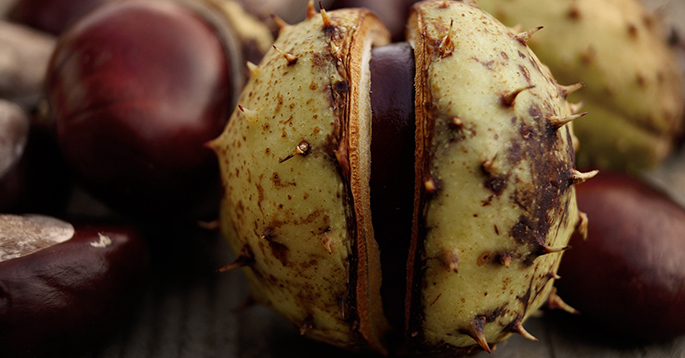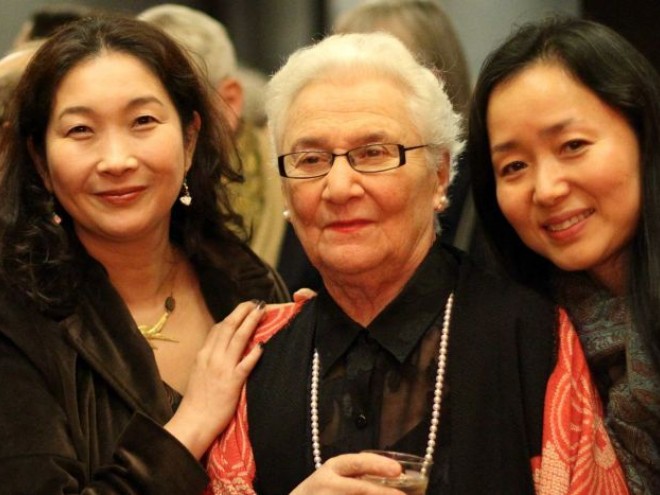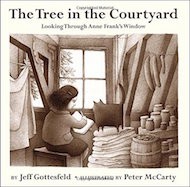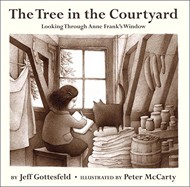Following Anne Frank’s birthday over the weekend, The Tree in the Courtyard author Jeff Gottesfeld is guest blogging for Jewish Book Council all week as part of the Visiting Scribe series here on The ProsenPeople.
There is a moment every artist dreams of, when an idea that is at least good gets transformed into something potentially transcendent, if only the artist can execute it.
In my case, I can’t remember where I read the story of how the 172 year-old horse chestnut tree in the courtyard behind 263 Prinsengracht, Amsterdam, had cracked in half in a storm.
The lede choked me up. I had gazed at that tree on a dreary day in 1981, stared at it as Anne Frank might have though the attic window of the hiding place above the same courtyard — the only window in the annex that had not been covered by improvised curtains that Anne had helped her father to sew. I learned later how Anne wrote about the tree three times in the diary, including an astonishing entry dated 23 February, 1944:
The two of us looked out at the blue sky, the bare chestnut tree glistening with dew, the seagulls and other birds glinting with silver as they swooped through the air, and we were so moved and entranced that we couldn’t speak.
In the decades after the campaign of exterminationist antisemitism roared out of Germany across World War II Europe, the chestnut tree became an etz chaim, a tree of life. After the Franks’s annex became a museum, millions gazed upon this tree as Anne and Peter once had. The tree sickened in the decade before its demise; botanists and tree surgeons had brought their best science to bear, engineers had erected a supporting scaffold for her in all-out effort to save its life. It was to no avail. The tree was gone.
I stared at my desktop monitor, sad and bitter all at once. A memory from Schindler’s List blew through my mind. It was the liquidation of the Krakow ghetto, seen and heard from afar. So many had perished there, and so few had tried to save them. In Amsterdam, so few had tried to save the girl. Sixty-odd years later, humanity was making its best efforts for a tree. A tree! The contrast rankled. Bile rose. I nearly clicked out of the story.
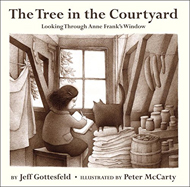 I’m glad I didn’t. A few moments later, I reached what for me was the most important part, about how other scientists were sprouting healthy baby saplings from the tree’s trunk and her seedpods. These would become new trees to be planted the world over. Eleven of them had been promised to the United States, in locations meaningful in the struggle for human dignity. I have photograph of my book, The Tree in the Courtyard, resting against one of these saplings at the Holocaust Memorial Center in Farmington Hills, Michigan. There are others at the September 11th memorial in Manhattan; Central High School in Little Rock, Arkansas, and more.
I’m glad I didn’t. A few moments later, I reached what for me was the most important part, about how other scientists were sprouting healthy baby saplings from the tree’s trunk and her seedpods. These would become new trees to be planted the world over. Eleven of them had been promised to the United States, in locations meaningful in the struggle for human dignity. I have photograph of my book, The Tree in the Courtyard, resting against one of these saplings at the Holocaust Memorial Center in Farmington Hills, Michigan. There are others at the September 11th memorial in Manhattan; Central High School in Little Rock, Arkansas, and more.
Just as Anne Frank’s diary may live on for a hundred generations after we are dust and ashes, these new trees will drop tens, then hundreds, then thousands of seedpods. So will their progeny, and their progeny’s progeny. There could come a time when every school, synagogue, church, mosque, town hall, and courthouse that wanted one might have a tree-from-the-tree-in-the-courtyard growing as a massive etz chaim, a living reminder of mankind’s confounding nature: our potential for good and penchant for evil.
There it was, that golden artistic moment. There was the story. It was one worth telling. Yet good as the idea was, I was left with a massive problem. How could I tell it in a way that would be worth reading? I got the cockamamie idea that I should write this as a picture book for grade school kids — I’ve been fortunate to have a reasonable career as a writer and author, but I’d never written a picture book manuscript in my life.
That problem would occupy me for five weeks. It ended with me giving up. Then, two years later, I got the line that would become the spine of the book: The tree recalled how few had tried to save the girl. It was the seed I needed. I was on my way.
Jeff Gottesfeld is an award-winning writer for page, stage, and screen. He has previously written for adult, teen, and middle-grade audiences; The Tree in the Courtyard is his first picture book.
Related Content:
- Nat Bernstein: Anne Frank, the “Belieber”
- Anne Frank and the Remembering Tree by Rabbi Sandy Sasso
- Anne Frank’s Chestnut Tree by Jane Kohuth
Jeff Gottesfeld is an acclaimed writer for page, stage, and screen. His work has won awards from the American Library Association, the Writers Guild of America, and the National Council for the Social Studies. He has previously written for adult, teen, and middle-grade audiences; The Tree in the Courtyard is his first picture book, and No Steps Behind is his second.
